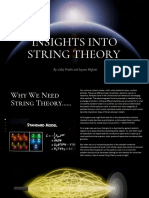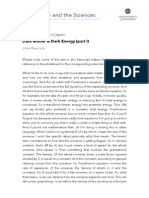Dimensions
Dimensions
Uploaded by
Nene WiltrowwCopyright:
Available Formats
Dimensions
Dimensions
Uploaded by
Nene WiltrowwCopyright
Available Formats
Share this document
Did you find this document useful?
Is this content inappropriate?
Copyright:
Available Formats
Dimensions
Dimensions
Uploaded by
Nene WiltrowwCopyright:
Available Formats
Who's Counting? Is it 10 or 11? (dimensions, that is ---M Theory is making me Manic!
)
Yes, it looks strange. The physicists that claim to have a beautiful and consistent theory of quantum gravity cannot agree on the number of dimensions!. The surprising answer is that it can be both, 10 and 11!. What happens is that the classical notion of spacetime looses its meaning in the quantum theory. It is replaced by a more general concept, a quantum spacetime where the dimension is not a well defined notion. We know a great deal about certain quantum spacetimes and they have many precise properties, but their dimension is not one of them. In fact, string theory leads to very surprising phenomena which clash our intuitive geometrical notions. Perhaps the simplest example arises when we have a circular dimension. Namely a dimension that is periodic, so that after traveling along a distance L along this dimension we come back to the point were we started. It turns out that in string theory a circle with size L is the same as a circle of size L=(2ls)2/L, where ls is the typical size of a string, which is determined by its tension. How does this happen? Let us imagine how we would measure this dimension. When the circle is very large, then we can use just a metric tape. As it gets smaller, then we start seeing quantum effects. A particle moving along this circle has a quantized momentum. For simplicity, consider a massless particle. We can measure the size of the dimension by looking at the energy levels for this particle which are quantized with a characteristic spacing which is inversely proportional to the size. When we continue decreasing L these particles become more and more energetic. However, besides these particles we can have other excitations. For example, we can wrap a string on this circle. If the circle is very small these wound strings are very light. It turns out that these wound strings on a very small circle of size L are completely equivalent to massless particles moving along a circle of size L=(2ls)2/L . In this simple example all that happens is that a very small circle becomes equivalent to a big circle. In this example the number of dimensions did not change, but there are other cases where it does. For example, a strings moving on a small three dimensional sphere which has the size of a string are equivalent to strings moving on a circle. The number of dimensions changes. It is three in one description while it is only one in the other. In addition, in string theory we can have spaces which have no geometric interpretation at all.
So if the number of dimensions is not well defined in string theory, why do people talk about it?. In string theory, what we know for sure is that the number of dimensions we need to describe the world we live in is greater than four. The cases when we have 10 or 11 are specially simple, and people have concentrated in studying these cases. They are simpler because in these cases the internal dimensions, namely the dimensions beyond the four we see, can be relatively large so that we can describe them using geometrical language. By relatively large I mean larger than the size of the string but smaller than any
distance that we can experimentally see today. If the total number of dimensions is not 10 or 11, then necessarily some of the dimensions have string size and are therefore harder to describe. What is the difference between 10 and 11?. The simplest string theory is ten dimensional. Strings can interact with each other. If the interaction among strings is large, the theory is hard to describe. It turns out that when strings interact very, very strongly, something surprising happens. A new dimension opens up and we have a theory in eleven dimensions, the ten we started with plus an extra circle. In eleven dimensions we do not have strings, we have membranes. Membranes wrapped along the 11th dimension give rise to strings. We do not know yet whether a description in terms of 10 or 11 dimensions is more appropriate for the universe where we live in. But these two possibilities are continuously connected. They are simply different possibilities for the internal geometry. Since the geometry of the internal space is quantum mechanical, asking what its dimension is might not be the right question. One of the main lessons from recent developments is that the concept of spacetime itself will have to be replaced by some other concept at the quantum level. Let us just consider an analogy. Let us consider the surface of a lake. If we are classical physicists we would describe the waves that propagate on this surface, we will be able to say if we are above the surface or below the surface, etc. On the other hand, when we look at the lake with very high resolution we start seeing the individual water molecules. Then the surface of the lake becomes a lot less sharp. In fact, the surface is not a well defined concept at the atomic level. There are molecules constantly leaving the water into the air and vice-versa. We can only talk about the surface of the lake at macroscopic distances. The same happens with spacetime, we can use the standard geometric description only at long enough distances. Of course, in the case of spacetime we would need to go to distances smaller than the distances that are experimentally accessible today in order to see that the concept is breaking down. But string theory predicts, that just as in the case of the surface of the lake, spacetime will loose its meaning at very short distances. Of course this does not mean that we cannot describe the system. In the case of the water, we have a well defined description of the system in terms of the water molecules. Similarly, in the case of spacetime we have a good description of what is going on, at least in some special circumstances. But this description uses less intuitive variables, which we do not have the space to describe in more detail. In summary, in a quantum spacetime the dimension might not be a well defined notion. When the space in question is small, it can interpolate continuously between different dimensions.
Prof. Juan Maldacena Institute for Advanced Study
You might also like
- Format For Critical AnalysisDocument6 pagesFormat For Critical AnalysisJm JoreinNo ratings yet
- Summary - What Is Not TheoryDocument3 pagesSummary - What Is Not TheoryLogistics team100% (1)
- Hypothesis - Testing - Random MotorsDocument7 pagesHypothesis - Testing - Random MotorsNancy ChenNo ratings yet
- HGFIHIHGSIHUSDGUSDGSDGDocument4 pagesHGFIHIHGSIHUSDGUSDGSDGTristan ScottNo ratings yet
- By Jalaj Pruthi and Jayant MiglaniDocument11 pagesBy Jalaj Pruthi and Jayant MiglaniJalaj PruthiNo ratings yet
- The Philosophy of FractalsDocument407 pagesThe Philosophy of FractalsKawaguchi Oerke100% (1)
- Lec 15Document19 pagesLec 15Janarthanan K SNo ratings yet
- Einstein DerivationDocument12 pagesEinstein DerivationJosh PilipovskyNo ratings yet
- Andrei Linde - Doc 0Document13 pagesAndrei Linde - Doc 0Atheistube Broadcasting FreethoughtNo ratings yet
- What Is Quantum PhysicsDocument11 pagesWhat Is Quantum PhysicsMarta DiasNo ratings yet
- The slang of astronomers: A small guide to understand the language of astrophysicistsFrom EverandThe slang of astronomers: A small guide to understand the language of astrophysicistsNo ratings yet
- Rain 3Document4 pagesRain 3Parachute IndonesiaNo ratings yet
- Geometry and TopologyDocument14 pagesGeometry and TopologySai Swetha KVNo ratings yet
- Einstein Fields EquationsDocument23 pagesEinstein Fields Equationsdendi231No ratings yet
- Joe's Little Book of String Class Notes, Phys 230A, String Theory, Winter 2010Document90 pagesJoe's Little Book of String Class Notes, Phys 230A, String Theory, Winter 2010Nelson Mechán ZuritaNo ratings yet
- Time and Background Independence: A ResponseDocument7 pagesTime and Background Independence: A ResponsecalamartNo ratings yet
- 3.2 Dark Matter and Dark Energy (Part I)Document5 pages3.2 Dark Matter and Dark Energy (Part I)jcvoscribNo ratings yet
- What Is 11 Diemnsion?Document2 pagesWhat Is 11 Diemnsion?peterinspiresNo ratings yet
- Theories About The Origin of The UniverseDocument5 pagesTheories About The Origin of The UniverseJasmine MaturanNo ratings yet
- The gauge theory_Afrah MustafaDocument11 pagesThe gauge theory_Afrah MustafaAfrah MustafaNo ratings yet
- The Theory of EverythingDocument58 pagesThe Theory of EverythingBlackHole NerdNo ratings yet
- Symmetry: Introduction To A Quantum Theory Over A Galois FieldDocument36 pagesSymmetry: Introduction To A Quantum Theory Over A Galois FieldEkaNo ratings yet
- L04 ThermodynamicsDocument27 pagesL04 ThermodynamicsADAMU MUSA SANINo ratings yet
- The Daniel Papers, Part 4: Extra-Dimensional & Extra-Terrestrial EntitiesDocument16 pagesThe Daniel Papers, Part 4: Extra-Dimensional & Extra-Terrestrial Entitiesmiss_sacredNo ratings yet
- Entanglement Made SimpleDocument4 pagesEntanglement Made SimpleMilan BasuNo ratings yet
- Entanglement Made Simple: James O'BrienDocument10 pagesEntanglement Made Simple: James O'BrienathulpjoseNo ratings yet
- Atom Galaxies and UnderstandingDocument56 pagesAtom Galaxies and UnderstandingNikhilesh ThatipamulaNo ratings yet
- For Fqxi Essay Contest 2016-17 Physical Mathematics Explaining The Physics of Ten DimensionsDocument9 pagesFor Fqxi Essay Contest 2016-17 Physical Mathematics Explaining The Physics of Ten DimensionsSalman HAIDERNo ratings yet
- FractalDocument15 pagesFractalpoorna1111No ratings yet
- Windows On The Universe - PeeblesDocument6 pagesWindows On The Universe - PeeblesluitnoiNo ratings yet
- Vedic Yoga, Seth and Multidimensional CosmologyDocument35 pagesVedic Yoga, Seth and Multidimensional CosmologySenthilkumar SatyavruthanNo ratings yet
- String Theory N Quantum GravityDocument2 pagesString Theory N Quantum GravityFUN PHYSICS FOR NEETNo ratings yet
- (Canto) P. C. W. Davies, J. R. Brown (Eds) - The Ghost in The Atom - A Discussion of The Mysteries of Quantum Physics-Cambridge University Press (2008) - 101-172-1-50 PDFDocument50 pages(Canto) P. C. W. Davies, J. R. Brown (Eds) - The Ghost in The Atom - A Discussion of The Mysteries of Quantum Physics-Cambridge University Press (2008) - 101-172-1-50 PDFgilberto espinosaNo ratings yet
- Space-Time and Cosmology: Roger PenroseDocument45 pagesSpace-Time and Cosmology: Roger PenroseStefan AleksicNo ratings yet
- Lec 5Document5 pagesLec 5smalhaar111No ratings yet
- The Edges of Our UniverseDocument45 pagesThe Edges of Our UniverseSam RasydNo ratings yet
- The Seven Symmetrical Universes: Ahmad SudirmanDocument12 pagesThe Seven Symmetrical Universes: Ahmad SudirmansufisalmansNo ratings yet
- Order Parameters, Broken Symmetry, and Topology: PACS Numbers: KeywordsDocument10 pagesOrder Parameters, Broken Symmetry, and Topology: PACS Numbers: KeywordsDanielleMcGillicuttyNo ratings yet
- To What Extent Does String Theory Provide A 'Theory of Everything'?Document4 pagesTo What Extent Does String Theory Provide A 'Theory of Everything'?miaherkanaiduNo ratings yet
- Special Relativity-Sylvain Poirier PDFDocument18 pagesSpecial Relativity-Sylvain Poirier PDFMarioGreenNo ratings yet
- Science and UniverseDocument8 pagesScience and UniverseDravid AryaNo ratings yet
- Homework General RelativityDocument4 pagesHomework General Relativityafodchdfatakdf100% (1)
- Lec 12Document22 pagesLec 12Mohammed AlauddinNo ratings yet
- Intro To Quantum MechanicsDocument9 pagesIntro To Quantum MechanicsAshangelV1No ratings yet
- Heisenberg, "Über Den Anschaulichen Inhalt Der Quantentheoretischen Kinematik Und Mechanik"Document16 pagesHeisenberg, "Über Den Anschaulichen Inhalt Der Quantentheoretischen Kinematik Und Mechanik"Benjamin Crowell50% (2)
- Bandstructure ExplanationDocument119 pagesBandstructure Explanation3femtoNo ratings yet
- AP Physics A - NotesDocument208 pagesAP Physics A - NotessandruandraNo ratings yet
- Theory of GravityDocument6 pagesTheory of GravityKyle ByrneNo ratings yet
- The Nature of LightDocument10 pagesThe Nature of Lightjc58No ratings yet
- Space, Time and Gravitation - An Outline of the General Relativity TheoryFrom EverandSpace, Time and Gravitation - An Outline of the General Relativity TheoryRating: 4 out of 5 stars4/5 (1)
- Superstring TheoryDocument2 pagesSuperstring TheoryRhitam DuttaNo ratings yet
- Is Space FiniteDocument5 pagesIs Space FiniteUwe KlaasNo ratings yet
- Lec 22Document17 pagesLec 22Janarthanan K SNo ratings yet
- Mathematics - Vedic Yoga, Seth and Multidimensional CosmologyDocument22 pagesMathematics - Vedic Yoga, Seth and Multidimensional CosmologyThad LekartovskiNo ratings yet
- The Theory of EverythingDocument9 pagesThe Theory of EverythingZENITH ParmarNo ratings yet
- Fractal 3Document15 pagesFractal 3Kathleen MangualNo ratings yet
- DeLanda On DeleuzeDocument10 pagesDeLanda On DeleuzeBernardo OliveiraNo ratings yet
- Lec 13Document20 pagesLec 13Mohammed AlauddinNo ratings yet
- String Theory (Layman Description)Document13 pagesString Theory (Layman Description)Nikhil BaghelNo ratings yet
- QMMDocument54 pagesQMMgladwin thomasNo ratings yet
- Rocinante 36 Marengo 32 Mileage (KM/LTR) Top Speed (KM/HR) Mileage (KM/LTR) Top Speed (KM/HR)Document15 pagesRocinante 36 Marengo 32 Mileage (KM/LTR) Top Speed (KM/HR) Mileage (KM/LTR) Top Speed (KM/HR)rohitbodhaniNo ratings yet
- Introductionto Meta AnalysisDocument10 pagesIntroductionto Meta AnalysisDr. Aysha KhalilNo ratings yet
- Dba 503 - J1Document10 pagesDba 503 - J1Alvin Cardoza DE VillaNo ratings yet
- Pedoman SKTTK Pengoperasian Distribusi-28102017Document178 pagesPedoman SKTTK Pengoperasian Distribusi-28102017Tafif NurhudaNo ratings yet
- Appraising Progress in International Relations Theory: Colin Elman and Miriam Fendius ElmanDocument68 pagesAppraising Progress in International Relations Theory: Colin Elman and Miriam Fendius Elmankapil.sisNo ratings yet
- THEME 2 - The Method With A Quantitative ApproachDocument21 pagesTHEME 2 - The Method With A Quantitative ApproachAndres AlvaradoNo ratings yet
- Exploring The Use of Entity-Relationship DiagrammiDocument24 pagesExploring The Use of Entity-Relationship Diagrammiagung wirakurniawanNo ratings yet
- Random Variables Random Variables - A Random Variable Is A Process, Which When FollowedDocument2 pagesRandom Variables Random Variables - A Random Variable Is A Process, Which When FollowedsdlfNo ratings yet
- PathDocument6 pagesPathAbdulNo ratings yet
- LESSONDocument27 pagesLESSONgseangaliaNo ratings yet
- BAYE's TheormDocument27 pagesBAYE's TheormPravalika ReddyNo ratings yet
- Karl Popper's Philosophy of ScienceDocument17 pagesKarl Popper's Philosophy of Sciencenira_110No ratings yet
- Schrodinger's Train of ThoughtDocument29 pagesSchrodinger's Train of Thoughthellhawk123No ratings yet
- Appendix Table 7 - Upper Critical Values of Chi-Square DistributionDocument2 pagesAppendix Table 7 - Upper Critical Values of Chi-Square DistributionNhi Nguyễn Trần LiênNo ratings yet
- Proposal Revisi Delfi 2 - 100500Document31 pagesProposal Revisi Delfi 2 - 100500belolucky94No ratings yet
- Scientific Method Anchor ChartDocument3 pagesScientific Method Anchor Chartapi-725921276No ratings yet
- Sample 4Document8 pagesSample 4Bharat SoniNo ratings yet
- Project MathsDocument14 pagesProject Mathsupadhyayyuvraj68No ratings yet
- S.No. Experiment Date: IndexDocument24 pagesS.No. Experiment Date: Indexvisha13No ratings yet
- Volume 9: Statistical Physics, Part 2 Volume 10: Physical KineticsDocument1 pageVolume 9: Statistical Physics, Part 2 Volume 10: Physical KineticsMamta GoyalNo ratings yet
- Deduction and InductionDocument2 pagesDeduction and InductionmavimalikNo ratings yet
- Power FunctionDocument7 pagesPower Functionrifka fakhiraNo ratings yet
- Testing of HypothesesDocument19 pagesTesting of HypothesesMahmoud RefaatNo ratings yet
- Thomas KuhnDocument18 pagesThomas Kuhnnira_110No ratings yet
- Soil Dynamics and Earthquake Engineering: Shima Taheri, Reza Karami MohammadiDocument20 pagesSoil Dynamics and Earthquake Engineering: Shima Taheri, Reza Karami MohammadiSumit SahaNo ratings yet
- Vitalism PhilosophyDocument2 pagesVitalism PhilosophyAwais TareqNo ratings yet

























































































